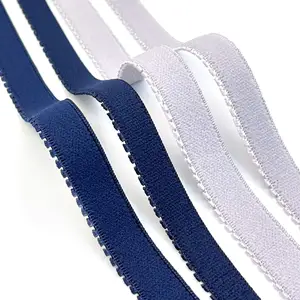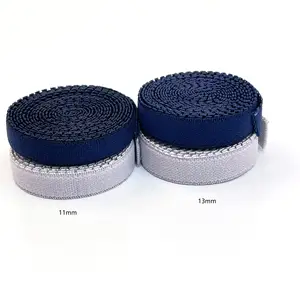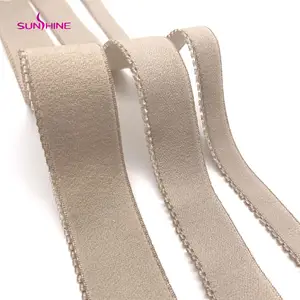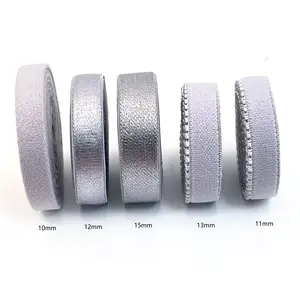
All categories
Featured selections
Trade Assurance
Buyer Central
Help Center
Get the app
Become a supplier

(1270 products available)














































Elastic with picot is a decorative material used in sewing and garment-making. Here are some of its types:
Flat Picot Elastic
This type is characterized by a row of small, rounded shapes (the picots) along one or both edges of the elastic. This elastic material is thin and flexible in nature and is often used to furnish a stretchable edge with a feminine appeal. It is commonly used in the making of lingerie, such as bras and panties, as well as in the production of soft garments like baby clothes and camisoles. The picots provide a delicate, lace-like detail that enhances the visual appeal of the fabric.
Circular Picot Elastic
This type is characterized by tiny, rounded shapes (the picots) that are evenly distributed along the circumference of the elastic. This elastic material is thin and flexible in nature and is often used to furnish a stretchable edge with a feminine appeal. It is commonly used in the making of lingerie, such as bras and panties, as well as in the production of soft garments like baby clothes and camisoles. The picots provide a delicate, lace-like detail that enhances the visual appeal of the fabric.
Knitted Picot Elastic
This type of elastic is produced using a knitting process that forms a series of small loops or picots along its length. It has good stretch characteristics, making it suitable for applications that require both elasticity and a decorative edge. It is often used in garments like skirts, dresses, and activewears, where a stretchy and decorative trim is needed. The picots provide a consistent and attractive edge, enhancing the overall design of the garment.
Woven Picot Elastic
This type of elastic is produced using a weaving process that forms a series of small loops or picots along its length. It has good stretch characteristics, making it suitable for applications that require both elasticity and a decorative edge. It is often used in garments like skirts, dresses, and activewears, where a stretchy and decorative trim is needed. The picots provide a consistent and attractive edge, enhancing the overall design of the garment.
Picot Edge Lace Trim
This type of lace trim features a series of small, rounded peaks or picots along the edges, creating a delicate and decorative finish. It is commonly used for edging fabrics, garments, and accessories to add a touch of elegance and femininity. This trim can be made from various materials, including cotton, nylon, or polyester lace fabrics. It is widely used in sewing and crafting projects, such as adding embellishments to dresses, blouses, curtains, and lingerie. The picot edge provides a distinctive and charming detail that enhances the overall appearance of the item.
Picot elastic is a very versatile type of fabric that is used in various applications; hence, its design is made to be versatile too. The following are some of the key design elements that picot elastic incorporates.
Charming Appearance
The design of picot elastic is characterized by a small loop or a decorative lace-like edge that is formed by making tiny loops called picots along the side of the elastic. It is available in different widths and thicknesses. Some of the designs are narrow and thin, measuring about 1/2 inch wide, while others are broad and thick, measuring about 2 inches wide. Based on the application and requirement, some are smooth while others are textured. The texture is smooth and has a silky feel, while the textured one has a rough feel and a certain degree of texture.
Functional Characteristics
One of the key design functions of elastic with picot is to provide stretch and flexibility. When incorporated into garments and accessories, it allows for easy wearing and removal and a comfortable fit. The picot edging also serves a functional role. It helps prevent the elastic from slipping or rolling. This is particularly important in applications such as lingerie, where a secure fit is crucial.
Versatility and Applications
Versatility is a hallmark of picot edge elastic. It is used in various applications across the apparel and accessories spectrum. In lingerie, it adds a delicate touch to bras and panties while ensuring a snug fit. It is used in the production of dresses, tops, and blouses, where it is used in the neckline and the cuff area. It is also used in home textiles, where it is used to decorate curtains, cushions, and tablecloths. Besides, it is also used in making footwear, where it is used to make shoes, sandals, and boots.
Integration with Fabrics
The integration of picot elastic with fabrics requires consideration of both its functional and aesthetic characteristics. When it is used in stretchy fabrics like jersey or spandex, it enhances the garment's ability to conform to the wearer's shape. It also increases the garment's stretchability. When combined with woven fabrics like cotton or silk, it adds a decorative touch and assists in providing structure and support. This is especially in the case of lightweight or loosely woven materials.
Maintenance and Care
Maintaining picot elastic is relatively straightforward. It is hand or machine washed in cold water with mild detergent. It's important to avoid using bleach or harsh chemicals that can damage the elastic fibers or lace-like picot edging. It should also not be ironed or pressed as high temperatures can cause the elastic to lose its stretch properties. Drying should be done in the air, preferably laid flat to maintain its shape and prevent any undue tension on the elastic.
Picot elastic is versatile and can be used in various applications, so it is important to know how to wear and combine it with other materials. Here are five ideas for wearing and matching this elastic to create stylish and comfortable garments:
For a feminine touch, pair the picot with lace. The delicate lace complements the scalloped edges of the picot for a romantic style. Use this combination on a blouse or dress for an elegant look. Combine the picot with ruffles for a fun and playful style. The ruffles add volume and movement, while the picot keeps the ruffles in place. Use this combination on a skirt or dress for a playful and whimsical look.
Match the picot with a contrasting color for a bold and striking look. The contrasting color makes the picot stand out and adds visual interest. Use this combination on a waistband or cuff for a bold and eye-catching look. Pair the picot with a textured fabric for an interesting and dynamic look. The texture of the fabric adds depth, and the picot provides a finished edge. This combination works well on a blouse or dress for a unique and stylish look.
Combine elastic with picot with beads or sequins for a touch of glamour. The beads or sequins add sparkle and shine, and the picot provides a decorative edge. This combination is suitable for a special occasion or evening wear.
Q1: What are the key characteristics of elastic with picot?
A1: Elastic with picot is characterized by its flexibility, which allows it to stretch and return to its original length. The picot border, which is a small decorative loop or scallop, is usually attached to one side of the elastic. This gives the fabric a lacy appearance and is very useful in garments such as lingerie, where it is used to give a snug fit around the legs and waist.
Q2: What materials are commonly used to make elastics with picots?
A2: The materials used to make picot elastics include polyester, nylon, cotton, and blends of these materials. Cotton and polyester blends are usually used in garments that are intended to be worn for long periods of time because of their comfort. Nylon elastics are favored for their strength and durability.
Q3: What is the typical width of elastic with a picot?
A3: The width of the picot elastic varies depending on the thickness of the elastic and the size of the picot loops. The width ranges from 6 mm to about 25 mm. The smaller widths are used for garments such as underwear and socks, while the larger widths are used for dresses, blouses, and other types of accessories.
Q4: Can the elastic with picot be used for both stretch and decorative purposes?
A4: Yes, the elastic with picot serves both functional and decorative purposes. The elasticity allows it to be used in areas where stretch is needed, such as in the waistbands of garments or the edges of lace trim. At the same time, the picot edge adds a decorative touch, giving a lacy or scalloped appearance to garments and accessories.
Q5: Are there different types of picot edges, and how are they created?
A5: Yes, there are different types of picot edges, each created using different techniques. The simplest method involves folding the fabric over a certain distance and stitching it to form a series of loops. More complex methods may involve using a special picot gauge or tool to create evenly spaced loops. Some picot edges are created using a combination of knitting or crocheting techniques.